3. Like trying to Mould Clay
In the previous interview, I spoke with some of the younger developers that worked on the latest Zelda. This time, I have been joined by more experienced developers who over the years have become accustomed to working on Zelda titles. I'd like to ask each of you to introduce yourself. Let's start with you, Kawagoe-san.
My name is Kawagoe, and I was the cinematic scene director for Twilight Princess. As the cinematic scene director, I was responsible for the so-called movie cut-scenes that are shown in order to advance the story. Before this project, I worked as the cinematic scene director on Ocarina of Time, Majora's Mask and Wind Waker.
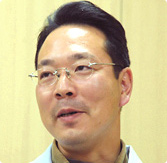
OK, next is Asakawa-san.
I'm Asakawa. On this project, I was in charge of bringing together various elements related to the non-player characters (NPCs) in the game. In previous projects, I was responsible for the NPCs in Ocarina of Time, Pokémon Stadium 2, Majora's Mask and Super Mario Sunshine. I worked on the enemies and cut-scenes in Pikmin and Pikmin 2, and was in charge of the boss character animations in Wind Waker.
I see. Takano-san?
My name is Takano. I was basically in charge of the story scripting for Twilight Princess, but I was also involved in the development of the cut-scenes and a few of the events in the game. After 1080° Snowboarding was finished, I worked in a supporting role in the development of Ocarina of Time. I've been working on nothing but Zelda ever since! (laughs)
You're practically living in a Zelda game, aren't you? (laughs)
Sometimes I think I might be! (laughs)
OK, next up is Takizawa-san.
My name is Takizawa. I was the artwork director for Twilight Princess. I was basically in charge of organising the work of all the artists, which entailed a large range of responsibilites. For example, I was responsible for determining the overall direction of the artistic style as well as the technology that we used. I also had to make sure the artists had everything they needed to do their work. Before this project, I got my start with Super Mario 64, which was followed by Star Fox 64. After that, I was involved with Ocarina of Time. Since then, just like Takano-san, I have been living, eating, and breathing Zelda projects! (laughs) Let's see, I was also the artwork manager for Wind Waker.
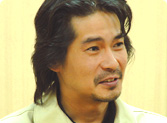
What was different about your role this time as artwork director compared to your role as artwork manager on Wind Waker?
On Wind Waker, when we decided to go ahead with that graphical style, the decisions about the overarching effects were made in consultation with other staff members. With Twilight Princess, in addition to directly working on those kinds of design-related issues, I feel that I had more things to do that were required to keep the project moving forward. For example, I had to make sure that the artists in every section had all the tools they needed as well as responding to requests to hire more staff with in-demand skills.
Do you think the fact that this kind of work was required means that more people were involved with artwork on this project than anything else we have ever done?
Definitely, without a doubt.
I see. Next is Miyanaga-san.
My name is Miyanaga. I was the sub-director for Twilight Princess. I was mainly in charge of devising game content and positioning various characters in the field portion of the game. After working on Ocarina of Time, Twilight Princess is actually just my second time working on a Zelda project. I was the field designer for Ocarina of Time, and I was basically in charge of designing Hyrule Field in that game.
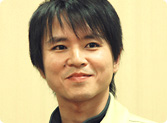
Last but not least, we have Ikematsu-san.
I'm Ikematsu. My title for this project was planning sub-director and I was primarily responsible for the dungeons, in particular the dungeon layouts and the positioning of enemies. My first experience with the Zelda series was as the dungeon designer for Ocarina of Time. After that, I worked on Majora's Mask and was in charge of the planning for Wind Waker before working on this project.
I would like to start off by asking you what you felt was different about the development of Twilight Princess compared to previous games in the Zelda series. I thought it best to ask all of you since you have so many years of experience on Zelda projects. Takano-san, what would you say was different this time around?
Well, I would say that because there were such a huge number of people working on this project, there were also a lot of differences in each individual's perception of Zelda. On top of that, everyone was very stubborn about their opinions, too! (laughs) So of course there weren't many cases in which everyone agreed on how to proceed. It was much more common to have people voicing their disagreement and offering constructive criticism. As a result, the developers probably debated this Zelda with more fervour than any other Zelda game to date, and I think that passion is evident in the game. I'm sure that the director, Aonuma-san, had to expend a good deal of effort to bring everything together. But in the end I believe he succeeded in doing just that, and the result is the biggest Zelda to date.
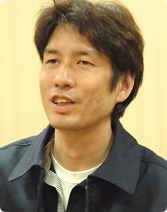
So because of the large size of this project, it was more difficult to make sure everyone was on the same page than it was with any other Zelda?
Yes, that's right.
I see. What about you, Takizawa-san?
Speaking from the point of view of an artist, the sheer volume of work meant that we needed the assistance of both the company's internal artists as well as that of several temporary workers. With the increased staff size, it became even more important to properly care for everyone, effectively communicate the project's direction and manage the progress of the project. Also, the creation of some things that used to be hammered out by senior and junior artists working together closely had to be delegated to people who were not necessarily familiar with our internal processes. And not only for the artists, but for all the team leaders on this project, there was a lot of delegation and project management that couldn't be avoided because of the large scale of the project. Since no one really had a lot of experience in those areas, I think each of the team leaders had to use a process of trial and error to learn how to organise their work.
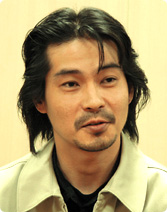
With a project of this magnitude, I think that many of the people with experience on previous Zelda games were asked to fill a wide variety of new roles. But I imagine that it was surely difficult to fully grasp the big picture due to the enormous number of in-game names, characters and events, and that probably made giving accurate instructions difficult. That means without people who have a good grasp of the entire game constantly running about trying to keep everyone on the same page, the project would run aground. Without such people, I can imagine misunderstandings piling up on top of each other and there being countless contradictions in the game. What was it really like?
We definitely encountered those kinds of problems. In fact, it would be fair to say that we were constantly dealing with them! (laughs)
It was a very big issue during development.
Takano-san, you worked on bringing together the outline of the story to a certain extent, so I think you were probably conscientious about understanding the bigger picture from an early stage. Wasn't that a lot of work for you this time around?
Well, the plots of Zelda games have always been broadly outlined by the director at the beginning. Then each time a new and interesting gameplay element is devised, something is later added to the story to accommodate it.
Oh, so the emphasis isn't put on the story from the beginning?
Not at all. It's never been done like that.
So in a nutshell, the storyline of Zelda is created to bring out the best of the fun and interesting gameplay elements in such a way that the consistency of the story is maintained. I guess your biggest task is the balancing act required to make sure this is done successfully.
Yes, and that's why I was able to do my job effectively by going round to each section and absorbing information from them. Put another way, this project came together in the end because of how well each of the section leaders incorporated interesting things into the game.
Was there any particular event that gave this huge project its direction, or something that caused everyone to share the same vision for the project?
Well, at the beginning when we had a vague idea of what the story and events would be like, the art director Takizawa-san worked with the other artists to create actual in-game screens in order to show us a visual representation of the Twilight Princess world. When he showed it to us developers, it became clear to us what the theme for this game would be, and what the game world would be like. Before that, when the story was still only on paper, everyone had their own image in mind and it was difficult to get everyone to share the same vision. But when Takizawa-san and the others did this for us visually, things started to come together because it allowed everyone to understand for the first time what our direction ought to be and enabled us to make decisions such as how the dungeons and field areas should look.q
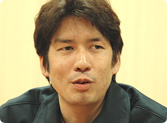
So everyone was able to agree on a vision for the project once there was a concrete image to refer to?
That's right.
So Takizawa-san, when you made those screens, did you feel that there was a need to bring everyone's vision of the game together?
Yes, I thought it would be better to show everyone something like that because the overall plan for the game wasn't quite coming together at the start. In game development, in principle I feel that the artists shouldn't just get together and make decisions on their own. I feel that artists should listen carefully to what the director, planners, and programmers say about what kind of game they want to make, and then offer suggestions.
So the way you see it, the role of artists is not to create a certain artistic style because that's what they want to make, but rather to pursue the best possible visual representation in response to the kind of game that the developers want to create, right?
Exactly.
That way of thinking is very characteristic of how things are usually done at Nintendo.
Well, of course I think it's acceptable for artists to make their own suggestions, but in order to make a good game it's very important to seek the most appropriate visual style for the game. That's why for a time I decided to take charge and create those images to give the project some momentum when I noticed that it had started to stall. But once the ball got rolling again, the leaders of each section resumed their central role of creating artwork that suited the content of the game.
I see. I think the best example of something that is difficult to make without finalised plans are the movies that Kawagoe-san was in charge of. Even if you try to make them early on, it might all be for nothing if the underlying premise is pulled out from underneath you. Kawagoe-san, you've created the movies not just for Zelda games, but for several other projects as well. Was there anything unique about this project?
Well, there were definitely a lot of undetermined factors in this project, but by now I've gotten used to that! (laughs) We overcame these difficulties by looking ahead and trying to make the storyboards in such a way that they could apply to various situations. We still had to make a lot of changes in the end, but we tried to foresee as many of the changes as possible.
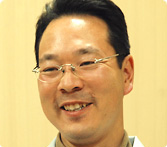
There was quite a buzz when the first Twilight Princess movie was shown at E3 in 2004 without prior announcement. Did your team make that movie?
Um, actually no. I wasn't fully involved with the project at that time.
The team in America was in charge of that movie. The amazing thing is that it looks like a cut-scene movie, but in reality it was compiled entirely with camera work of actual play on the ROM. There's someone in the American localisation team who is a genius when it comes to that kind of camera work. You wouldn't think it possible, but he was able to create that incredibly polished movie with normal gameplay.
He's a very enthusiastic Zelda fan. I think his passion for Zelda is what made that movie possible.
Oh, I didn't know that. When that movie was shown at E3, there was an incredibly enthusiastic reaction to it, wasn't there? Did you see it?
I most certainly did! (laughs)
There were even people in the crowd who were crying! (laughs) I expected the excited cheering, but I honestly didn't think anyone would be moved to tears. What were your impressions when you saw that reaction?
I was very pleased. Not only did I feel that way when the movie was shown, I found that it also motivated me during the development that followed. Since this was such a big project, there were times when everyone started to feel mentally drained. At those times, and even now I must admit, just thinking of that movie and the positive reaction to it is enough to keep me going! (laughs) And that's true not just for me, but for a lot of the other staff members as well. It was a great motivator.
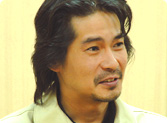
I see, I see.
The fact that it wasn't a movie, but footage of actual gameplay was also very motivating. We all felt that once we'd completed this project and gotten it out to everyone who was waiting for it, it would really blow them away!
For the artists, it was encouraging because it confirmed that we didn't choose the wrong direction in terms of the game's look. We had proof that everyone out there was impressed by the game's visual style.
It really felt like the reaction to that movie would cement the overall direction of the game. So of course, before E3 we were all quite nervous about whether or not everyone would like it.
The incredibly positive and enthusiastic response to that footage really reinforced the fact that we were going in the right direction. Development moved along much more smoothly after that.
It really did. I think that's especially true of the artwork department.
I think that people looking in from the outside think that Nintendo's Zelda team is incredibly experienced, capable of maintaining its motivation and carrying large projects through to the finish without any external input. But as it turns out, everyone on the Zelda development team is only human after all! (laughs) You're all nervous the first time you show your work to other people and you're happy when they like what you've done.
I was particularly nervous about Link's design. The reason for that is, although we were continuing with the aesthetic style of Ocarina of Time, the more realistic you make characters, the more they tend to start looking a bit like plastic dolls.
Although the visual design of Twilight Princess is indeed realistic, I think it has a unique atmosphere that conventional photo realism cannot offer. There were a lot of people, mostly from overseas, who said they really wanted to play a realistic-looking Zelda. I don't think it was easy for you to come up with a visual design that met those expectations. Could you tell me about what you struggled with in that area?
Well, among the artists it was clear from the start that we would not pursue photo realism in this game. We didn't see any reason to engage the competition in a struggle over who could make the most photo-realistic game, or any significance in attempting to recreate the real world for that matter. Rather, we felt that it would be more meaningful to create something we wanted to make, and then show the world what kind of game can be made when you have that kind of passion. So we decided to place our emphasis on creating the palpable atmosphere that everyone liked so much about Ocarina of Time.
But that's much easier said than done, isn't it? Surely everyone has their own individual artistic style and there were a huge number of people working on the graphics of this game. I think that it would be no small task to come up with a consistent atmosphere if everyone just drew whatever they felt like. How did you work around this issue?
This is actually something that always surprises me, but there's no special effort or fantastic trick to accomplishing this. It was the same when we were working on Ocarina of Time and Wind Waker. For example, the graphical style in Wind Waker was very unique, almost to a fault, but we never actually established a standard for everyone to follow. At the beginning we had Link's design, enemy designs based on that and the overall design of the first island. Just based on these sample designs, everyone was able to faithfully recreate the same style in the rest of the world. I always worry about it when we are in the middle of the process, but in the later stages of development the graphical style and movements always come together very quickly. Even this time around with Twilight Princess, we firmly established the basic lines we would work from right at the beginning of development and almost never worked on them again after that.
In other words, the early sample stages and the movie that was such a hit at E3 worked like "moving specification sheets", and everyone based their own work on those.
That's right. That's why our basic stance has always been to ask artists to come up with what they want.
So, Asakawa-san, how did you find it once the project actually got underway?
Well, I think that everyone basically shared the same idea about the direction to go in. But that's not to say there were any strict rules to follow, because that would lead to a lack of originality and make the creative process uninteresting, which would be the worst possible outcome. So the basic approach was to let people create what they wanted and then slightly modify the completed designs to ensure a Zelda-like consistency throughout the game. That approach was enough to get the job done effectively. Particularly in the later stages of developement, everyone really got into the swing of things.
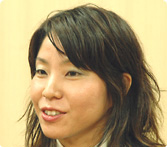
So that's how you do it! I had never imagined that it would be possible to create such an enormous game world without some poor person working around the clock to oversee everything and tie it all together. I don't want it to sound like I'm bragging about my own company, but listening to all of you talk reminds me how incredible the Entertainment Analysis & Development Division really is.
Although the artists had a lot of freedom, Takizawa-san regularly checked everything to make sure everyone was moving in the same direction.
So adjustments were made along the way before things got out of hand.
Yes. At key points of development, Takizawa-san and the other section leaders would make sure things were ticking along nicely.
I'd like to ask about aspects not related to artwork for a moment. Both Miyanaga-san and Ikematsu-san joined this project after it was already underway. What were your impressions when you first joined the team?
At the start, I was shown the E3 demo and I was really impressed. I was excited to see that they were already that far along, but as it turns out… well, they actually weren't all that far along yet!
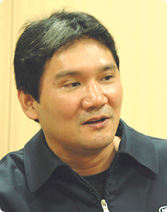
(laughter)
In actuality, the real work started after the E3 demo. We saw that everyone wanted to play in the world they saw in the demo, and so we went about working to make that a reality.
What about you, Miyanaga-san?
Well, I volunteered to join this team, and just like Ikematsu-san, I was astonished to find out that the overall structure of the game hadn't even been finalised yet! (laughs) All of the individual materials were there, but the foundation hadn't been laid yet. So we started by making that foundation.
In the team, we used to talk about starting by "making the box". What this means is that without a "box", that is a space to play, there was no way of verifying anything in the game, and no way to know how people would enjoy it. That's why we decided to begin our work by creating that box.
I think the most ideal approach is to make everything in an orderly manner after all the specifications are finalised, but Zelda has never been developed by creating things to meet specifications.
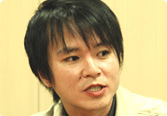
If you start out by finalising the specifications before creating anything, it probably wouldn't end up being Zelda.
I think that's right. That's why we absolutely had to start by making that box, or foundation, and then make fine-tuned adjustments in a way that resembled the moulding of clay.
Once the box is done, everyone can start putting things in it and it starts to become clear which ideas work well. Everyone shares their opinions and we gradually brush it up so that the good things stand out even more.
The ball gets rolling once you can talk specifically about what you like, doesn't it?
It does. It provides constant stimulus that allows you to gradually improve the game.
With several teams providing this positive stimulus for each other, there is a kind of chain reaction that continually increases the quality of the game. When one team comes up with something good, it inspires other teams to come up with even better ideas.
That definitely happens. Or someone sees something and thinks: "That idea works well there. Maybe we should give it a tweak and see if it works here, too." It becomes much easier to discuss modifying and adopting something you can actually see on the screen. This has the effect of accelerating the pace of development.
There are some things which you can't clearly comprehend when they're just on paper, so you can't really discuss them until they've actually been made. Otherwise it's too hard to see the problems and find the right solutions.
All the tweaking and fine-tuning that goes on after the game has taken shape really does provide the momentum that turns it into a finished product that feels like a Zelda game, doesn't it?
I think so. That's when everything starts to get interesting!
I think what you are all doing would never be possible by simply following the instructions in some thick specification plan.
